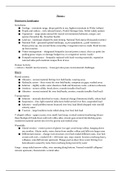Theme 1
Distinctive Landscapes
Snowdonia:
● Geology – mountain range, drops quickly to sea, highest mountain in Wales (1085m)
● People and culture – rich cultural history, World Heritage Sites, Welsh widely spoken
● Vegetation – range plant/animal life (varied environments/habitats), unique, rare
species (Snowdon lily, Snowdon beetle)
● Land use – landscape shaped by slate mining, National Park status (thousands tourists)
● National Park – glaciated upland landscape, 25,000 population, 4.3mil visitors/yr.
House prices up, rise second-home ownership. Congestion narrow roads. Rural income
up from tourists
● Visitor management – designated footpaths (access/protect areas), clear car parks (no
parking grass verges, no damage hedgerows, no congestion narrow roads)
● Footpath maintenance – footpaths replaced with hard-wearing materials, vegetation
restored sides path maintain unique flora of area
Human Activity:
+ visitors = benefit rural economy. – honeypot sites pose environmental challenges
Rivers
Fluvial erosion:
● Abrasion – stones/material hitting river bed/banks, wearing away
● Hydraulic action – force water hit river bed/banks, compress air gaps, washed away
● Solution – slightly acidic water dissolves chalk and limestone rocks -calcium carbonate
● Attrition – stones collide, break down, rounder/smaller (bed load)
● Abrasion – stones/material hit river bed/banks, erosion, rounder/smaller (bed load)
Transportation:
● Solution – minerals dissolved in water, chemical change (limestone/chalk), solute load
● Suspension – fine, light material (alluvium) held/carried river flow, suspended load
● Saltation – small pebbles/stones bounced river bed, load lifted/dropped with rise/fall
velocity water
● Traction – large boulders/rocks rolled along river bed, bed load
V-shaped valleys – upper course, river small, land steep, vertical erosion/weathering (freeze-
thaw/biological) break down soil/rock valley sides, stream goes around interlocking spurs,
weathered material carried into river by gravity and washed away
Waterfalls:
● Glacial erosion – erosive power of glacier (ice age) caved steep valleys, hanging above
one another. Glacier melts, water drains from smaller valleys and falls into larger ones
● Differential erosion – change rock structure, river bed eroded different rates, river bed
crosses soft rock = eroded (HA + AB) faster rate, step created. Erosion=overhang heavy,
collapses, waterfall retreats upstream. Plunge pool as sheer force water hitting river
bed/abrasion caused by rocks from overhang being moved by water
Gorge – steep-sided narrow valley, river running along bottom. Formed waterfall collapses/
retreats upstream, characteristic vertical sides
, Meanders – middle/lower course, bends in river when on wide floodplain. Outside – erosion,
river cliff, fast flow, deep water. Inside – deposition, slip-off slope, slow flow, shallow water
Floodplain – river floods, floodplain covered water, water shallower on land than river
(material/silt deposited), silt makes soil fertile
Coasts
Physical weathering - freeze-thaw action – rainwater enters cracks cliff face – night (temp
drops, water freezes/expands, crack bigger) – day (ice melts, more water to larger gap) –
repeats until rock falls off
Biological weathering – plant roots – plants grow cliff top – roots push into cracks in rocks –
rocks broken apart
Chemical weathering – carbonation – rainwater enters cracks cliff face – weak acid reacts
carbonates in limestone – cracks bigger
Rockfalls and landslides – once rock eroded upper part cliff, material down to beach = mass
movement
Cliff erosion:
● Hydraulic action – force waves crash cliffs, air trapped cracks compressed, breaks rock
● Abrasion – waves hurl sand/pebbles against cliff, wears land away
● Solution – salt water dissolves calcium carbonate rocks
● Attrition – pebbles rolled back/forth, collide, smaller/rounder = sand
Transportation and deposition:
● Eroded material (sediment) falls in sea, transported by power waves/currents along
coastline by longshore drift
● Swash – pushed up beach at same angle as wind
● Backwash – straight down beach due to pull gravity
Headland – area land juts into sea, formed due to harder/more resistant rock eroding slowly
Bay – between headlands due to softer/less resistant rock eroding quickly
Cliffs and wave-cute platforms:
● Waves pound base cliff, HA + AB cut wave-cut notch in base = more vulnerable
● Continues erosion at high tide = wave-cut notch makes cliff unstable/collapse
● Material from cliff moved by sea, AB smooth surface wave-cut platform left behind
● If cliff well-joined sedimentary rocks, wave-cut notch along bedding planes as they are
weak point (erode quicker)
Arches and stacks:
● Form in headlands resistant to erosion (limestone)
● Arches – 2 caves created either side of headland
● Sea cuts through back wall by HA + AB
● Water passes underneath rock, weathering erodes roof arch so higher and roof thinner
● Wave-cut notches form base of arch to widen it
● Eventually, arch roof collapses, leaving single pillar of rock (stack)
Beaches and spits:
● Formed when swash stronger than back swash and deposition occurs
● Beach – build up of sand, shingle and pebbles deposited by waves




